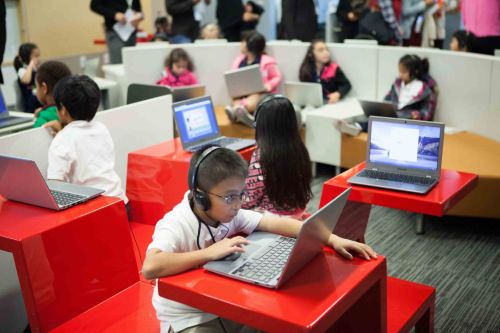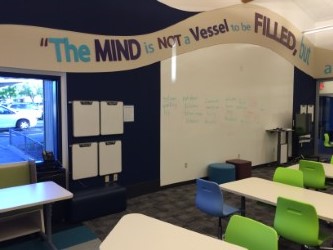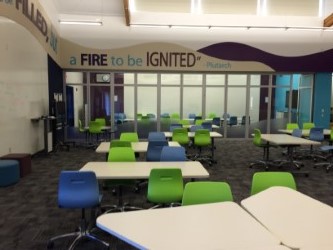The recently built Learning Lab at Pomeroy Elementary School is a large room with multi-colored chairs, cubbies for students to sit in, and tables where students work together. Part of the previous Superintendent’s plan for staff to redesign their schools for blended learning (see here), Pomeroy’s Learning Lab the morning of October 21, 2016 was filled with 28 sixth graders working on different tasks. “We are,” their teacher Deanna Sainten said,”doing blended learning to the max.”



After listening to the veteran teacher who has spent ten years at Pomeroy, I walked around and spoke to students sitting in pairs, trios, and alone. Three students told me that they were looking at a Scholastic News article called “Vote for Me,” about the Clinton/Trump campaign for president. They were reading the article and moving back-and-forth from the text to the worksheet with questions to answer. Another boy was writing in his notebook as he paged through his math text.
Two other 6th graders were working on their Personal Learning Plan checking which items they had “mastered,” (these show up in green on their screens) and ones that they have yet to complete (they show up in red). I asked them whether they had set goals for themselves–the PLP helps students acquire skills of self-assessment–and one showed me a screen shot of his goal labeled “Going to College.” The other boy still was at sea in figuring out how to use that part of the PLP.*
Elsewhere in the Learning Lab, I saw a line of about five students waiting to see Sainten sitting at a small desk. The students wanted the teacher to check their work or were asking questions about the task they were working on.
I walked over to other students to see what they were doing. One boy was writing out answers on a worksheet about Ron Jones’ Acorn People and then transferring his answers to his Chromebook. I asked him why he was doing that. He said: “It’s neater.” Two girls were working on the Scholastic News article on the presidential campaign and Googling on their tablets for information to answer questions. A boy and girl at a table were working on the Paleothic unit on their Chromebooks. Both were taking notes on their tablets from the readings they had done on screen. They said that after they were finished with the notes they would submit them to Ms. Sainten for her approval before they could move to assessing on screen how much they learned on this part of the Paleolithic era.
As I scanned the room every trio, pair, and individual were at work on different tasks.
At the 12′ X 12′ whiteboard under the banner: The Mind Is Not a Vessel To Be Filled But a Fire To Be Ignited–see above photo–a boy and girl were working out math problem called “opposites of numbers.” They were talking to one another and jotting down notes to be sent to the teacher after they were finished.
The teacher tells class that they have five minutes left to complete their work before returning to their room. Four students wait in line to see Sainten. She looks around the Learning Lab and says aloud to the group, “Make sure conversations are on task.”
With a minute before the buzzer sounds, teacher tells class: “You have to leave Learning Lab cleaner than you found it.” Students straighten out tables and chairs, pick up scraps of paper on the floor. Buzzer sounds. Students return to their classroom.
In those classrooms when upper-grade teachers are not in the Learning Lab, Sainten and colleagues organize their daily lessons around switching students between small groups, individual work, and large group instruction. The teachers rotate their students through various activities (reading, math, independent work using Chromebooks whenever appropriate) within a 45-minute lesson. For the primary teachers who do not have access to the Learning Lab, they do rotation of activities within the classroom (see below).
Pomeroy Elementary School has 761 students of whom 72% Asian, 12% Hispanic, 5% white, 1% African American and 10% mixed race or other. In addition, the school has 36% English Language Learners and 25% Free or Reduced Lunch (2015). Sheila Murphy Brewer is principal. She and an assistant principal, 29 teachers and 19 staff members run the school. Teachers and students live for six or more hours a day in a remodeled main building and a host of portables, many of which have been made permanent.
Built in 1967 as an “open space” school, within a few years walls went up and teachers reclaimed their own classrooms while still retaining common space in the primary grades. As the school grew in enrollment, portables were added and renovations occurred as did the addition of even more portables. The Learning Lab space is, in effect, a resurrection of “open space” in the original part of the school.

After leaving the Learning Lab, I walked over to visit Akshat Das’s 5th grade class. With 29 students, each wall laden with posters, students’ work, and photos, the room felt crowded. Students leave their back packs outside the room.


Das was seated at a table in the front of the room working with individual students who she called up one at a time to meet with her. The rest of the class were at work on different activities, some reading from their Chromebook screens, others in pairs taking notes and talking to one another, and even others helping classmates with a question. Das looks across the room and says: “eyes and ears up here,” meaning that students stop and look at her. “You have been working in pairs and if you need more help you can turn to others at your table, she says.”
A former parent at the school and volunteer, Das eventually acquired her credentials and began teaching at Pomeroy five years ago. Like her upper grade colleagues, she participated in Summit’s Base Camp and created lessons that could be used (and shared) among 5th grade teachers.
After class, Das told me that she works closely with one other 5th grade teacher, particularly on how best to manage time and do all that is required to help kids especially those who need help. She has shifted, she says, from “direct instruction” in content (she teaches science, language arts, math, social studies) to using the Personal Learning Plan after her summer work with Base Camp. Now, she says, content is available to students on their Chromebooks as they learn subject matter in different “modalities.”
Das also pointed out to me that 5th graders now learn far more and explicitly from each other. They work on their individual PLPs and know what they have finished and what they have to work on. They know how many items they have “mastered” and how many items in lessons need further work. She now parlays small groups working together, pairs, whole group instruction, and individual attention from her–as she was doing when I entered the room–into a complex lesson that unfolded as I was there.
According to Das, she has decentralized her instruction by using PLPs. Moreover, she has trained members of the class to be “mentors” to other students who need help on a particular skill. On one wall is a list of student names and the skills they have mastered. After being approved by Das, students write in their names and what content and skills they can help other 5th graders. When these “mentors” complete their tasks during a lesson they are then allowed to help other students who have asked them for aid.
Upper grade teachers had access to Learning Lab and had learned to use the PLP. What about the primary grades?
On another day, after interviewing the principal, I visited Pomeroy to see how primary grade teachers put “blended learning” into practice. As part of the school plan, these teachers did not have access to the Learning Lab. I saw two second grade classes (with a large common space between the two rooms) teach lessons by rotating students through three activities within the classroom.


For example, in Vicky Ramirez’s second grade room there are 23 boys and girls. She has been teaching at Pomeroy for over 20 years. Sitting in the back of the room I see 11 students using the iReady application with earphones/ear buds sitting at tables working on math in their Chromebooks (there is a cart of devices in the room). Ramirez, sitting in a rocker, works on reading with eight students sitting on rug. Elsewhere in the room, four boys are lying on rug working on clipboards that they have with tasks to complete.
Ramirez has divided the lesson into three activities: teacher-led reading group, independent work–boys with clipboards–and others using iReady. After about 15-20 minutes, the teacher announces that the students will rotate to another activity. Students respond quickly and some go up to Ramirez for reading, another group dons earphones and buds, and the rest work independently on worksheets.
Over the two morning visits to Pomeroy Elementary school, “blended learning” and “personalization” operated differently in the primary and upper grades of the school. The Learning Lab catered to the upper grades and in-class rotation of activities in the primary ones. In both instances, the use of the devices were in the background, not the foreground of each teacher’s lessons.
_________________________________
*The Personal Learning Plan and individual playlists for 5th and 6th graders in language arts, social studies, science, and math come from Pomeroy teachers’ involvement with Summit charter network creation of a Base Camp (see here). Fifth and 6th grade teachers at Pomeroy and Weller elementary schools had joined the Summit Base Camp during the summer of 2015 and that school year and the following summer had learned how to have students use the PLP and, in addition, had customized playlists for their upper-grade elementary school students. Sixth grade teacher Deanna Sainten, described above, had attended the Summit Base Camp.She and her colleagues had created lessons and units adapted to upper elementary grades since the Base Camp was tilted toward secondary schools.
The above description of Pomeroy students in the Learning Lab draws from this partnership with the Summit network of schools reaching out to other public schools (Interview with Principal Sheila Murphy-Brewer, October 21, 2016).

Hang on to those bell bottoms, they’ll come back into fashion some day. Remembering the Sputnik Panic of my childhood. We needed to produce more Werner Von Braun’s in America, so I took German as a 7th grader (and 8th grader, and ninth grader, ad infinitum). And the big innovation, the reason why this iteration of language learning couldn’t fail? Language labs. We sat and listened (day dreamed?) to German speakers talking to us through fancy new headphones that look just like the ones at this school. I can still say “Good Morning” and sing a bit of “Oh Tannenbaum”.
Thanks for the comment, Jerry.
Reblogged this on From experience to meaning… and commented:
Interesting post!
Thanks for re-blogging post on the elementary school.
Reblogged this on kadir kozan.
Thanks for re-blogging post on Pomeroy Elementary School.